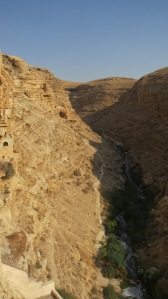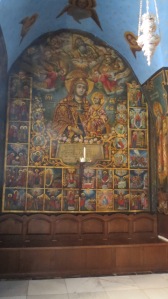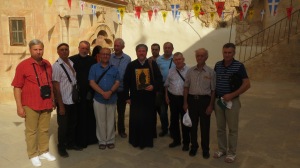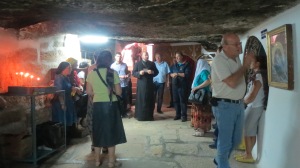It was the writer D J Chitty who described the Judean wilderness in these terms ‘the desert a city’. He was writing about the phenomenon in the 5th – 6th centuries which, during a period of relative stability for Christians, involved many men and women making their way into the deserts of the Middle East to embrace what was a hard and, over the years, a more dangerous life. A holy man, an Abba, a holy woman, an Amma, would attract hundreds to themselves, to live close by them in community, to benefit from their wisdom, to encounter God in the extremes of environment and daily living, in the extremes of spiritual discipline.
There are only remnants remaining of those glory days, but today I visited two ancient monasteries in the desert that formed part of this ‘desert city’ and still have resident monastic communities.
The journey into the Judean wilderness and to the area where these monasteries exist means entering the Palestinian Authority and driving beyond Bethlehem and the Shepherds Fields at Beit Sahour. Soon the villages end and the vast tracks of smooth but almost barren hills take over. This is very much the wilderness of the temptations. Stones are scattered over the hills.
The tempter came and said to Jesus, ‘If you are the Son of God, command these stones to become loaves of bread.’ But he answered, ‘It is written,
“One does not live by bread alone,
but by every word that comes from the mouth of God.” ’ (Matthew 4.3-4)
You can imagine many hermits sharing in that temptation and more besides. Abba Daniel said of Abba Arsenius
‘He lived with us many a long year and every year we used to take him only one basket of bread and when we went to find him the next year we would eat some of that bread.’
The Father was surviving on something more than bread and that level of austere living was being played out across the region and, indeed, amongst our own Celtic saints.

The first sight you get of Mar Saba are two towers poking up amongst the hills. Then you approach down a winding road. This monastery, founded by St Saba, began to be built in 483. It is in many ways the Mount Athos of Judea and with St Catherine’s in Sinai one of the oldest continuously inhabited Christian monasteries. Sadly, it is only open to male visitors, though women can look down upon it from one of the towers. There are now 20 monks in the community, where at times there have been over 400.
The monastic buildings cling to the steep sides of the Kidron Valley. Having crossed it in Jerusalem it is strange to discover it again here and with water flowing in it. On the opposite side of the valley can be seen hermitages built into the caves and the original cave dwelling of St Saba. It is phenomenally beautiful and peaceful, as is the monastery itself.

You enter the monastery itself through a small doorway guarded by a monk who also hands out cards and gifts of holy oil to the women who can go no further. The steps inside lead down to a courtyard. The first thing you see is an octagonal chapel dedicated to St Saba. His body is actually in the main monastic church but he is also venerated in this holy space.

The main church is large and contains the glass-topped ‘coffin’ that holds the saint’s relics. The church basically dates from 501 though it had to be restored, as did much of the monastery, after an earthquake in the 19th century. Out of the chapel you enter the Lateral Narthex which is decorated with more icons. From there you gain access to the gallery near a monastic logia which looks onto the Kidron Valley beneath you. It is utterly spectacular.

Back across the courtyard is the Chapel of St Nicholas. This is thought to be the original cave church which had a natural apse, a space for a sacristy and enough external light for St Saba to declare it to be the church for the community. The sacristy contains the skulls and other bones of the monks who were martyred by the Persians in 614. It is a gruesome reminder of the reality of life here and justifies the rather fortress-like appearance of the monastery.
One of the most famous members of the community was St John of Damascus, St John Damascene, one of the Doctors of the Church. He died at Mar Saba in 749, though his body is now lost having been taken from the monastery by the Crusaders. St John wrote prolifically but he is most remembered for combating the trend towards iconoclasm in the church of his day. This was begun in 726 following an edict by the Byzantine Emperor Leo III. It St John of Damascus, writing at Mar Saba, who we have to thank that the churches of the Orthodox tradition are full of the most wonderful icons and frescos.
In his ‘Apologia Against Those Who decry Holy Images’ he beautifully expresses the importance and role of images in these words
The image is a memorial, just what words are to a listening ear. What a book is to the literate, that an image is to the illiterate. The image speaks to the sight as words to the ear; it brings us understanding. … They were images to serve as recollections, not divine, but leading to divine things by divine power. (Apologia Against Those Who decry Holy Images Part I)
His arguments won the day though through a plot hatched by Emperor Leo III involving the Caliph in Damascus, the saint was wrongly implicated in a plot and had his hand cut off so he could write no more. But after prayers to the Theotokos, to whom the main church is dedicated, his hand was restored.

This monastery is full of wonderful images, including the guest room to which we were invited for coffee. At this point I have to confess that I’d secreted myself into a group of Romanian pilgrims. It is easier for groups to get in than individuals so I discovered. The Monk offering me hospitality asked if I was a Christian. ‘Yes’ I answered ‘a priest.’ ‘Catholic or Protestant’ he asked. ‘Anglican!’ I replied. ‘Oh, Anglican!’ he said with joy. ‘Welcome, Holy Father!’. It transpired that the Romanian priest leading his group of pilgrims had visited the Community of the Resurrection at Mirfield and was friends with Fr Nicholas Stebbing CR. So I was quickly included in the group photograph.
But to my shock instead of ‘cheese’ these men shouted out – for my benefit – ‘Brexit!’ Then we all laughed – which was probably the right response!!

There was a lot of laughter and I was reminded of another story of the Desert Fathers, a story associated with Abba Anthony the Great.
A hunter in the desert saw Abba Anthony enjoying himself with the brethren and he was shocked. Wanting to show him that it was necessary sometimes to meet the needs of the brethren, the old man said to him, ‘Put an arrow in your bow and shoot it.’ So he did. The old man then said, ‘Shoot another,’ and he did so. Then the old man said, ‘Shoot yet again and the hunter replied ‘If I bend my bow so much I will break it.’ Then the old man said to him, ‘It is the same with the work of God. If we stretch the brethren beyond measure they will soon break. Sometimes it is necessary to come down to meet their needs.’ When he heard these words “the hunter was pierced by compunction and, greatly edified by the old man, he went away. As for the brethren, they went home strengthened.
Driving back we passed the Monastery of St Theodosius which is on the edge of the village of al-Ubeidiya. The community resident there is made up of nuns and so all can enter. It was founded in 476 by Theodosius the Cenobiarch and contains his tomb. The buildings have been heavily restored but contain wonderful frescos. One shows the martyrdoms suffered in the area. In one scene some are being beheaded, others stabbed, one man is strung up upside down. An angel rescues a soul floating up from the flames. In the church is a cabinet containing more skulls and bones from the martyrs.

What was amazing however was to discover in the complex a cave called Metopa, the Cave of the Magi. The tradition is that the three Wise Men took shelter in this cave during the first night after leaving Bethlehem. They had given their gifts to the new-born Jesus. But then we read
Having been warned in a dream not to return to Herod, they left for their own country by another road. (Matthew 2.12)

This cave was on the road they left by. I was reminded of T S Eliot’s poem ‘The Journey of the Magi’ (that draws so heavily on a sermon by Bishop Lancelot Andrewes). The poem concludes
were we led all that way for
Birth or Death? There was a Birth, certainly
We had evidence and no doubt. I had seen birth and death,
But had thought they were different; this Birth was
Hard and bitter agony for us, like Death, our death.
We returned to our places, these Kingdoms,
But no longer at ease here, in the old dispensation,
With an alien people clutching their gods.
I should be glad of another death.
In this desert city where death stalked, life reigned. There was birth and death all around, the birth we receive through baptism, the death that brings us into life. It was a marvellous journey back into time, within time.
Lord,
for the Abbas and the Ammas of your church,
their wisdom and courage,
their devotion and sacrifice,
we thank you.
May I not be afraid to enter the desert
knowing that even in the driest place
you will refresh me.
Amen.
You must be logged in to post a comment.